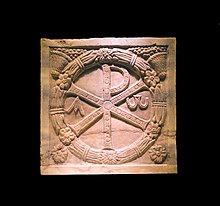

A Christogram (Latin: Monogramma Christi)[a] is a monogram or combination of letters that forms an abbreviation for the name of Jesus Christ, traditionally used as a religious symbol within the Christian Church.
One of the oldest Christograms is the Chi-Rho (☧). It consists of the superimposed Greek letters chi (Χ) and rho (Ρ), which are the first two letters of the Greek χριστός, 'Christ'. It was displayed on the labarum military standard used by Constantine I in 312 AD. The IX monogram (![]() ) is a similar form, using the initials of the name Ἰησοῦς (ὁ) Χριστός, 'Jesus (the) Christ', as is the ΙΗ monogram (
) is a similar form, using the initials of the name Ἰησοῦς (ὁ) Χριστός, 'Jesus (the) Christ', as is the ΙΗ monogram (![]() ), using the first two letters of the name ΙΗΣΟΥΣ, 'JESUS' in uppercase.
), using the first two letters of the name ΙΗΣΟΥΣ, 'JESUS' in uppercase.
There were a very considerable number of variants of "Christograms" or monograms of Christ in use during the medieval period, with the boundary between specific monograms and mere scribal abbreviations somewhat fluid.
The name Jesus, spelt ΙΗΣΟΥΣ in Greek capitals, has the abbreviations IHS (also written JHS, IHC, or ΙΗΣ). The name Christus , spelt ΧΡΙΣΤΟΣ, has XP (and inflectional variants such as IX, XPO, XPS, XPI, XPM). In Eastern Christian tradition, the monogram ΙϹΧϹ (with Overline indicating scribal abbreviation) is used for Ἰησοῦς Χριστός in both Greek and Cyrillic tradition.
A Middle Latin term for abbreviations of the name of Christ is chrisimus.[1] Similarly, the Middle Latin crismon, chrismon refers to the Chi-Rho monogram specifically.[2]
Cite error: There are <ref group=lower-alpha> tags or {{efn}} templates on this page, but the references will not show without a {{reflist|group=lower-alpha}} template or {{notelist}} template (see the help page).
- ^ Chrisimus (par les Bénédictins de St. Maur, 1733–1736), in: du Cange, et al., Glossarium mediae et infimae latinitatis, ed. augm., Niort : L. Favre, 1883‑1887, t. 2, col. 317b. "CHRISIMUS, Nomen Christi abbreviatum in antiquis instrumentis secundum diversos casus sic XPS. XPI. XPO. XPM. ubi media littera P. Græcum. Vox Chrisimus legitur in Annal. Benedict. tom. 5. pag. 7."
- ^ Crismon (par les Bénédictins de St. Maur, 1733–1736), in: du Cange, et al., Glossarium mediae et infimae latinitatis, ed. augm., Niort : L. Favre, 1883‑1887, t. 2, col. 621b. "CRISMON, Nota quæ in libro ex voluntate uniuscujusque ad aliquid notandum ponitur. Papias in MS. Bituric. Crismon vel Chrismon proprie est Monogramma Christi sic expressum ☧" 1 chrismon (par les Bénédictins de St. Maur, 1733–1736), in: du Cange, et al., Glossarium mediae et infimae latinitatis, ed. augm., Niort : L. Favre, 1883‑1887, t. 2, col. 318c, citing Heumann. de re Diplom. inde a Carol. M. § 12; Murator. Antiquit. Ital. tom. 3. col. 75.